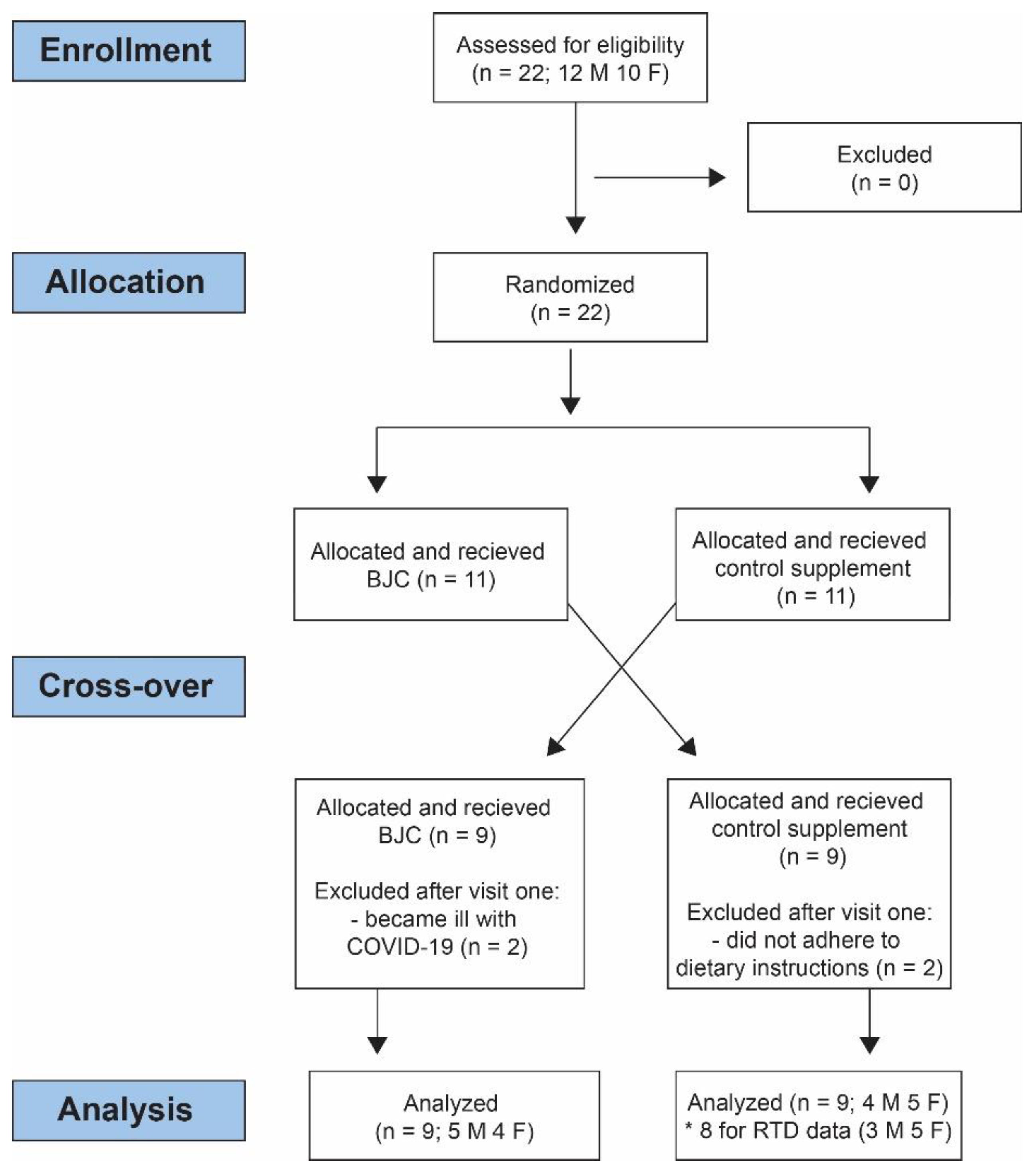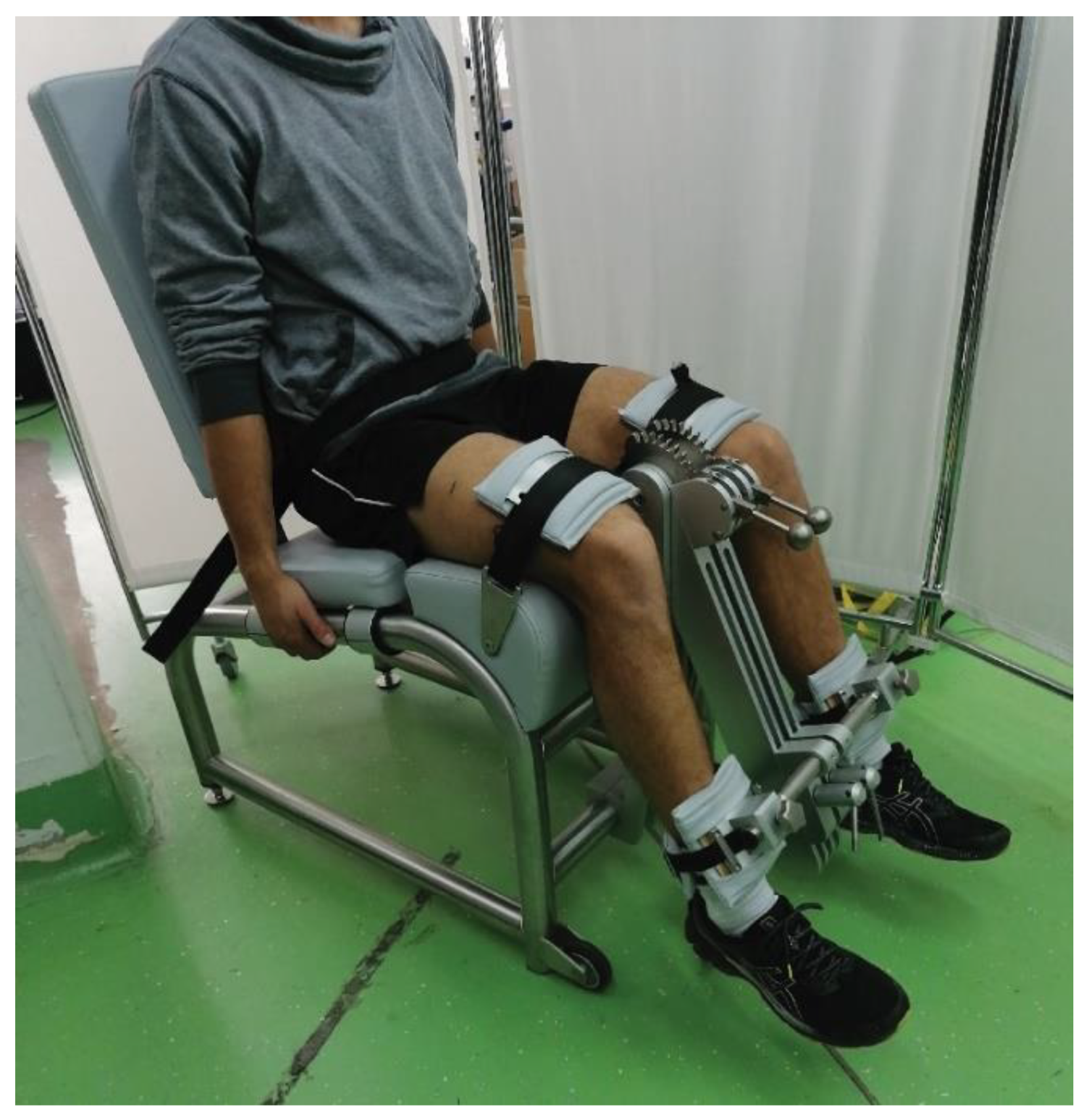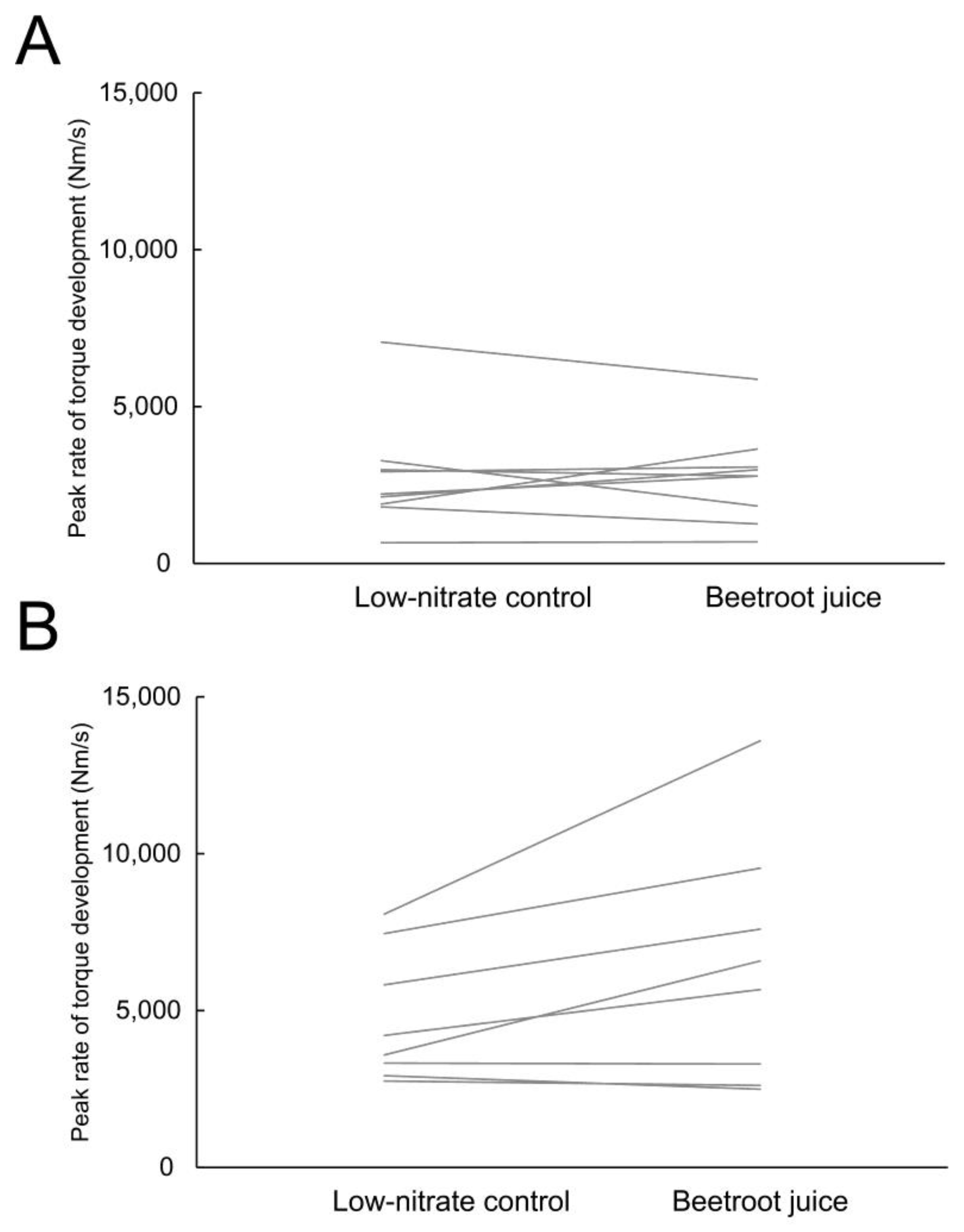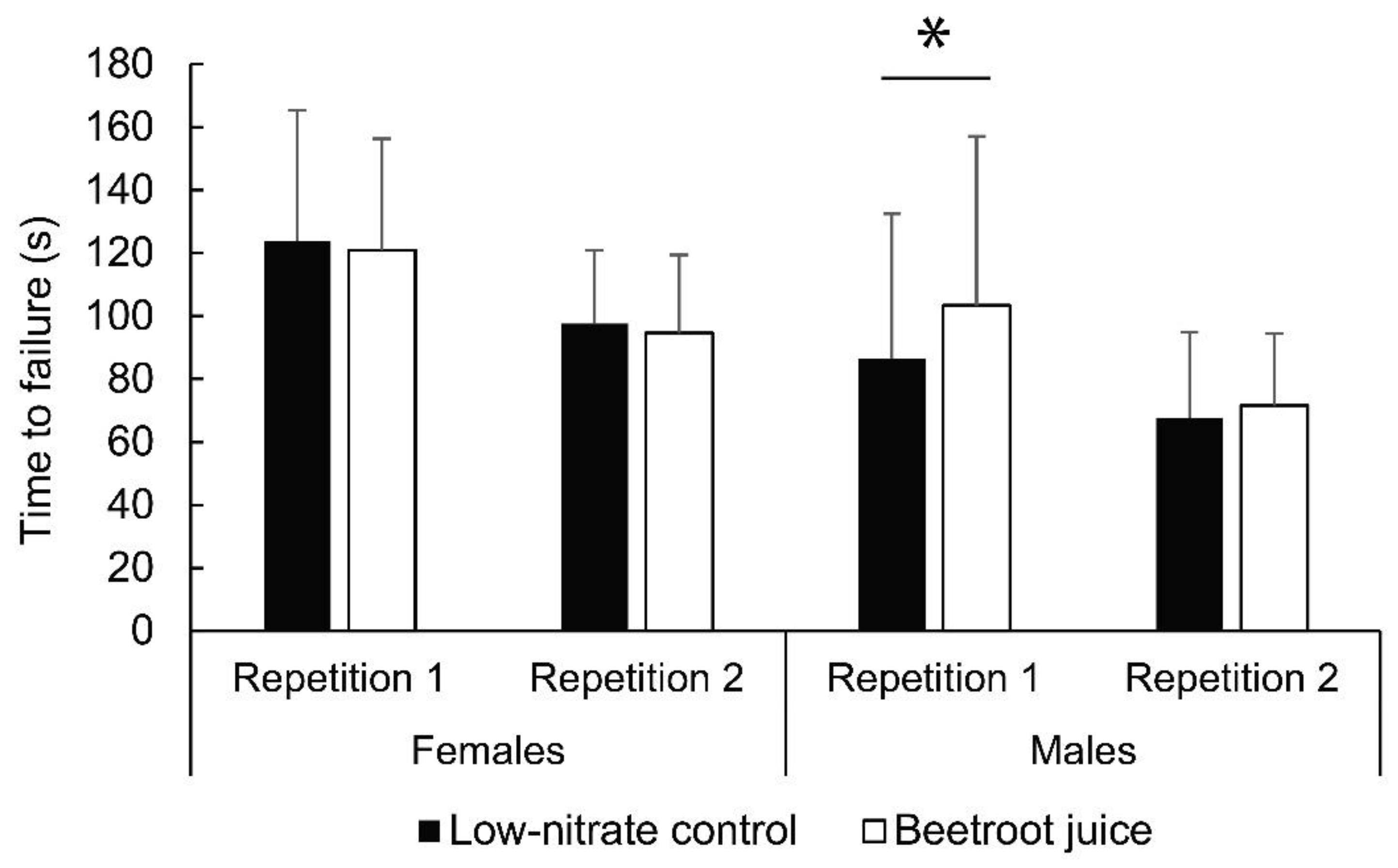Acute Effects of Beetroot Juice Supplementation on Isometric Muscle Strength, Rate of Torque Development and Isometric Endurance in Young Adult Men and Women: A Randomized, Double-Blind, Controlled Cross-Over Pilot Study
Abstract
1. Introduction
2. Materials and Methods
2.1. Participants
2.2. Study Design
2.3. Beetroot Juice Supplement and Low-Nitrate Control Supplement
2.4. Measurement Protocol
2.5. Data Analysis
2.6. Statistical Analysis
3. Results
3.1. Maximal Strength and RTD
3.2. Endurance
4. Discussion
5. Conclusions
Author Contributions
Funding
Institutional Review Board Statement
Informed Consent Statement
Data Availability Statement
Acknowledgments
Conflicts of Interest
References
- Stoclet, J.-C.; Chataigneau, T.; Ndiaye, M.; Oak, M.-H.; El Bedoui, J.; Chataigneau, M.; Schini-Kerth, V.B. Vascular Protection by Dietary Polyphenols. Eur. J. Pharmacol. 2004, 500, 299–313. [Google Scholar] [CrossRef]
- d’Unienville, N.M.A.; Blake, H.T.; Coates, A.M.; Hill, A.M.; Nelson, M.J.; Buckley, J.D. Effect of Food Sources of Nitrate, Polyphenols, L-Arginine and L-Citrulline on Endurance Exercise Performance: A Systematic Review and Meta-Analysis of Randomised Controlled Trials. J. Int. Soc. Sports Nutr. 2021, 18, 76. [Google Scholar] [CrossRef]
- Potter, L.; Angove, H.; Richardson, D.; Cole, J. Nitrate Reduction in the Periplasm of Gram-Negative Bacteria. Adv. Microb. Physiol. 2001, 45, 51–112. [Google Scholar] [CrossRef]
- Tamme, T.; Reinik, M.; Roasto, M.; Juhkam, K.; Tenno, T.; Kiis, A. Nitrates and Nitrites in Vegetables and Vegetable-Based Products and Their Intakes by the Estonian Population. Food Addit. Contam. 2006, 23, 355–361. [Google Scholar] [CrossRef]
- Arciero, P.J.; Miller, V.J.; Ward, E. Performance Enhancing Diets and the PRISE Protocol to Optimize Athletic Performance. J. Nutr. Metab. 2015, 2015, 715859. [Google Scholar] [CrossRef]
- Burke, L.M. To Beet or Not to Beet? J. Appl. Physiol. 2013, 115, 311–312. [Google Scholar] [CrossRef][Green Version]
- Maughan, R.J.; Burke, L.M.; Dvorak, J.; Larson-Meyer, D.E.; Peeling, P.; Phillips, S.M.; Rawson, E.S.; Walsh, N.P.; Garthe, I.; Geyer, H.; et al. IOC Consensus Statement: Dietary Supplements and the High-Performance Athlete. Int. J. Sport Nutr. Exerc. Metab. 2018, 28, 104–125. [Google Scholar] [CrossRef]
- Jones, A.M. Dietary Nitrate Supplementation and Exercise Performance. Sports Med. 2014, 44, 35–45. [Google Scholar] [CrossRef]
- Hoon, M.W.; Johnson, N.A.; Chapman, P.G.; Burke, L.M. The Effect of Nitrate Supplementation on Exercise Performance in Healthy Individuals: A Systematic Review and Meta-Analysis. Int. J. Sport Nutr. Exerc. Metab. 2013, 23, 522–532. [Google Scholar] [CrossRef]
- Kerksick, C.M.; Wilborn, C.D.; Roberts, M.D.; Smith-Ryan, A.; Kleiner, S.M.; Jäger, R.; Collins, R.; Cooke, M.; Davis, J.N.; Galvan, E.; et al. ISSN Exercise & Sports Nutrition Review Update: Research & Recommendations. J. Int. Soc. Sports Nutr. 2018, 15, 38. [Google Scholar] [CrossRef]
- Vitale, K.; Getzin, A. Nutrition and Supplement Update for the Endurance Athlete: Review and Recommendations. Nutrients 2019, 11, 1289. [Google Scholar] [CrossRef]
- Domínguez, R.; Cuenca, E.; Maté-Muñoz, J.; García-Fernández, P.; Serra-Paya, N.; Estevan, M.; Herreros, P.; Garnacho-Castaño, M. Effects of Beetroot Juice Supplementation on Cardiorespiratory Endurance in Athletes. A Systematic Review. Nutrients 2017, 9, 43. [Google Scholar] [CrossRef]
- Stamler, J.S.; Meissner, G. Physiology of Nitric Oxide in Skeletal Muscle. Physiol. Rev. 2001, 81, 209–237. [Google Scholar] [CrossRef]
- Ferguson, S.K.; Hirai, D.M.; Copp, S.W.; Holdsworth, C.T.; Allen, J.D.; Jones, A.M.; Musch, T.I.; Poole, D.C. Impact of Dietary Nitrate Supplementation via Beetroot Juice on Exercising Muscle Vascular Control in Rats. J. Physiol. 2013, 591, 547–557. [Google Scholar] [CrossRef]
- Hernández, A.; Schiffer, T.A.; Ivarsson, N.; Cheng, A.J.; Bruton, J.D.; Lundberg, J.O.; Weitzberg, E.; Westerblad, H. Dietary Nitrate Increases Tetanic [Ca2+] i and Contractile Force in Mouse Fast-Twitch Muscle. J. Physiol. 2012, 590, 3575–3583. [Google Scholar] [CrossRef]
- Domínguez, R.; Maté-Muñoz, J.L.; Cuenca, E.; García-Fernández, P.; Mata-Ordoñez, F.; Lozano-Estevan, M.C.; Veiga-Herreros, P.; da Silva, S.F.; Garnacho-Castaño, M.V. Effects of Beetroot Juice Supplementation on Intermittent High-Intensity Exercise Efforts. J. Int. Soc. Sports Nutr. 2018, 15, 2. [Google Scholar] [CrossRef]
- Fulford, J.; Winyard, P.G.; Vanhatalo, A.; Bailey, S.J.; Blackwell, J.R.; Jones, A.M. Influence of Dietary Nitrate Supplementation on Human Skeletal Muscle Metabolism and Force Production during Maximum Voluntary Contractions. Pflügers Arch. Eur. J. Physiol. 2013, 465, 517–528. [Google Scholar] [CrossRef]
- Hoon, M.W.; Fornusek, C.; Chapman, P.G.; Johnson, N.A. The Effect of Nitrate Supplementation on Muscle Contraction in Healthy Adults. Eur. J. Sport Sci. 2015, 15, 712–719. [Google Scholar] [CrossRef]
- Jonvik, K.L.; Hoogervorst, D.; Peelen, H.B.; de Niet, M.; Verdijk, L.B.; van Loon, L.J.C.; van Dijk, J.-W. The Impact of Beetroot Juice Supplementation on Muscular Endurance, Maximal Strength and Countermovement Jump Performance. Eur. J. Sport Sci. 2021, 21, 871–878. [Google Scholar] [CrossRef]
- Tillin, N.A.; Moudy, S.; Nourse, K.M.; Tyler, C.J. Nitrate Supplement Benefits Contractile Forces in Fatigued but Not Unfatigued Muscle. Med. Sci. Sport. Exerc. 2018, 50, 2122–2131. [Google Scholar] [CrossRef]
- Vieira de Oliveira, G.; Diniz do Nascimento, L.; Volino-Souza, M.; do Couto Vellozo, O.; Silveira Alvares, T. A Single Oral Dose of Beetroot-Based Gel Does Not Improve Muscle Oxygenation Parameters, but Speeds up Handgrip Isometric Strength Recovery in Recreational Combat Sports Athletes. Biol. Sport 2020, 37, 93–99. [Google Scholar] [CrossRef]
- López-Samanes, Á.; Pérez-López, A.; Moreno-Pérez, V.; Nakamura, F.Y.; Acebes-Sánchez, J.; Quintana-Milla, I.; Sánchez-Oliver, A.J.; Moreno-Pérez, D.; Fernández-Elías, V.E.; Domínguez, R. Effects of Beetroot Juice Ingestion on Physical Performance in Highly Competitive Tennis Players. Nutrients 2020, 12, 584. [Google Scholar] [CrossRef]
- Papadopoulos, S.; Dipla, K.; Triantafyllou, A.; Nikolaidis, M.G.; Kyparos, A.; Touplikioti, P.; Vrabas, I.S.; Zafeiridis, A. Beetroot Increases Muscle Performance and Oxygenation During Sustained Isometric Exercise, but Does Not Alter Muscle Oxidative Efficiency and Microvascular Reactivity at Rest. J. Am. Coll. Nutr. 2018, 37, 361–372. [Google Scholar] [CrossRef]
- Bender, D.; Townsend, J.R.; Vantrease, W.C.; Marshall, A.C.; Henry, R.N.; Heffington, S.H.; Johnson, K.D. Acute Beetroot Juice Administration Improves Peak Isometric Force Production in Adolescent Males. Appl. Physiol. Nutr. Metab. 2018, 43, 816–821. [Google Scholar] [CrossRef]
- Lago-Rodríguez, Á.; Domínguez, R.; Ramos-Álvarez, J.J.; Tobal, F.M.; Jodra, P.; Tan, R.; Bailey, S.J. The Effect of Dietary Nitrate Supplementation on Isokinetic Torque in Adults: A Systematic Review and Meta-Analysis. Nutrients 2020, 12, 3022. [Google Scholar] [CrossRef]
- Buckthorpe, M.; Roi, G.S. The Time Has Come to Incorporate a Greater Focus on Rate of Force Development Training in the Sports Injury Rehabilitation Process. Muscle Ligaments Tendons J. 2019, 07, 435. [Google Scholar] [CrossRef]
- Taber, C.; Bellon, C.; Abbott, H.; Bingham, G.E. Roles of Maximal Strength and Rate of Force Development in Maximizing Muscular Power. Strength Cond. J. 2016, 38, 71–78. [Google Scholar] [CrossRef]
- Rall, J.A.; Wahr, P.A. Role of Calcium and Crossbridges in Modulation of Rates of Force Development and Relaxation in Skinned Muscle Fibers. Adv. Exp. Med. Biol. 1998, 453, 219–228. [Google Scholar] [CrossRef]
- Haider, G.; Folland, J.P. Nitrate Supplementation Enhances the Contractile Properties of Human Skeletal Muscle. Med. Sci. Sport. Exerc. 2014, 46, 2234–2243. [Google Scholar] [CrossRef]
- Lee, S.; Abel, M.G.; Thomas, T.; Symons, T.B.; Yates, J.W. Acute Beetroot Juice Supplementation Does Not Attenuate Knee Extensor Exercise Muscle Fatigue in a Healthy Young Population. J. Exerc. Nutr. Biochem. 2019, 23, 55–62. [Google Scholar] [CrossRef]
- Ranchal-Sanchez, A.; Diaz-Bernier, V.M.; De La Florida-Villagran, C.A.; Llorente-Cantarero, F.J.; Campos-Perez, J.; Jurado-Castro, J.M. Acute Effects of Beetroot Juice Supplements on Resistance Training: A Randomized Double-Blind Crossover. Nutrients 2020, 12, 1912. [Google Scholar] [CrossRef]
- Gasier, H.G.; Reinhold, A.R.; Loiselle, A.R.; Soutiere, S.E.; Fothergill, D.M. Effects of Oral Sodium Nitrate on Forearm Blood Flow, Oxygenation and Exercise Performance during Acute Exposure to Hypobaric Hypoxia (4300 M). Nitric Oxide 2017, 69, 1–9. [Google Scholar] [CrossRef]
- Wigmore, D.M.; Propert, K.; Kent-Braun, J.A. Blood Flow Does Not Limit Skeletal Muscle Force Production during Incremental Isometric Contractions. Eur. J. Appl. Physiol. 2006, 96, 370–378. [Google Scholar] [CrossRef]
- Pincivero, D.M.; Gandaio, C.B.; Ito, Y. Gender-Specific Knee Extensor Torque, Flexor Torque, and Muscle Fatigue Responses during Maximal Effort Contractions. Eur. J. Appl. Physiol. 2003, 89, 134–141. [Google Scholar] [CrossRef]
- Haizlip, K.M.; Harrison, B.C.; Leinwand, L.A. Sex-Based Differences in Skeletal Muscle Kinetics and Fiber-Type Composition. Physiology 2015, 30, 30–39. [Google Scholar] [CrossRef]
- Roepstorff, C.; Thiele, M.; Hillig, T.; Pilegaard, H.; Richter, E.A.; Wojtaszewski, J.F.P.; Kiens, B. Higher Skeletal Muscle A2AMPK Activation and Lower Energy Charge and Fat Oxidation in Men than in Women during Submaximal Exercise. J. Physiol. 2006, 574, 125–138. [Google Scholar] [CrossRef]
- Tarnopolsky, M.A.; Rennie, C.D.; Robertshaw, H.A.; Fedak-Tarnopolsky, S.N.; Devries, M.C.; Hamadeh, M.J. Influence of Endurance Exercise Training and Sex on Intramyocellular Lipid and Mitochondrial Ultrastructure, Substrate Use, and Mitochondrial Enzyme Activity. Am. J. Physiol. Regul. Integr. Comp. Physiol. 2007, 292, R1271–R1278. [Google Scholar] [CrossRef]
- Zaras, N.; Stasinaki, A.N.; Spiliopoulou, P.; Arnaoutis, G.; Hadjicharalambous, M.; Terzis, G. Rate of Force Development, Muscle Architecture, and Performance in Elite Weightlifters. Int. J. Sports Physiol. Perform. 2021, 16, 216–223. [Google Scholar] [CrossRef]
- Mclellan, C.P.; Lovell, D.I.; Gass, G.C. The Role of Rate of Force Development on Vertical Jump Performance. J. Strength Cond. Res. 2011, 25, 379–385. [Google Scholar] [CrossRef]
- Saghaei, M.; Saghaei, S. Implementation of an Open-Source Customizable Minimization Program for Allocation of Patients to Parallel Groups in Clinical Trials. J. Biomed. Sci. Eng. 2011, 04, 734–739. [Google Scholar] [CrossRef]
- Šarabon, N.; Rošker, J.; Fruhmann, H.; Burggraf, S.; Loefler, S.; Kern, H. Reliability of Maximal Voluntary Contraction Related Parameters Measured by a Novel Portable Isometric Knee Dynamometer. Phys. Medizin Rehabil. Kurortmed. 2013, 23, 22–27. [Google Scholar] [CrossRef]
- Maffiuletti, N.A.; Aagaard, P.; Blazevich, A.J.; Folland, J.; Tillin, N.; Duchateau, J. Rate of Force Development: Physiological and Methodological Considerations. Eur. J. Appl. Physiol. 2016, 116, 1091–1116. [Google Scholar] [CrossRef] [PubMed]
- Bakeman, R. Recommended Effect Size Statistics for Repeated Measures Designs. Behav. Res. Methods 2005, 37, 379–384. [Google Scholar] [CrossRef] [PubMed]
- Bernards, J.R.; Sato, K.; Haff, G.G.; Bazyler, C.D. Current Research and Statistical Practices in Sport Science and a Need for Change. Sports 2017, 5, 87. [Google Scholar] [CrossRef]
- Koo, T.K.; Li, M.Y. A Guideline of Selecting and Reporting Intraclass Correlation Coefficients for Reliability Research. J. Chiropr. Med. 2016, 15, 155–163. [Google Scholar] [CrossRef]
- Whitfield, J.; Gamu, D.; Heigenhauser, G.J.; van Loon, L.J.; Spriet, L.L.; Tupling, A.R.; Holloway, G.P. Beetroot Juice Increases Human Muscle Force without Changing Ca2+-Handling Proteins. Med. Sci. Sport. Exerc. 2017, 49, 2016–2024. [Google Scholar] [CrossRef]
- Esen, O.; Dobbin, N.; Callaghan, M.J. The Effect of Dietary Nitrate on the Contractile Properties of Human Skeletal Muscle: A Systematic Review and Meta-Analysis. J. Am. Nutr. Assoc. 2022, 1–12. [Google Scholar] [CrossRef]
- Del Vecchio, A. Neuromechanics of The Rate of Force Development. Exerc. Sport Sci. Rev. 2022. ahead of print. [Google Scholar] [CrossRef]
- Stanhewicz, A.E.; Wenner, M.M.; Stachenfeld, N.S. Sex Differences in Endothelial Function Important to Vascular Health and Overall Cardiovascular Disease Risk across the Lifespan. Am. J. Physiol. Circ. Physiol. 2018, 315, H1569–H1588. [Google Scholar] [CrossRef]
- Kapil, V.; Rathod, K.S.; Khambata, R.S.; Bahra, M.; Velmurugan, S.; Purba, A.; Watson, D.; Barnes, M.R.; Wade, W.G.; Ahluwalia, A. Sex Differences in the Nitrate-Nitrite-NO• Pathway: Role of Oral Nitrate-Reducing Bacteria. Free Radic. Biol. Med. 2018, 126, 113–121. [Google Scholar] [CrossRef]
- Hayashi, T.; Yamada, K.; Esaki, T.; Kuzuya, M.; Satake, S.; Ishikawa, T.; Hidaka, H.; Iguchi, A. Estrogen Increases Endothelial Nitric Oxide by a Receptor Mediated System. Biochem. Biophys. Res. Commun. 1995, 214, 847–855. [Google Scholar] [CrossRef]
- Coggan, A.R.; Broadstreet, S.R.; Mikhalkova, D.; Bole, I.; Leibowitz, J.L.; Kadkhodayan, A.; Park, S.; Thomas, D.P.; Thies, D.; Peterson, L.R. Dietary Nitrate-Induced Increases in Human Muscle Power: High versus Low Responders. Physiol. Rep. 2018, 6, e13575. [Google Scholar] [CrossRef] [PubMed]
- Stea, T.H.; Nordheim, O.; Bere, E.; Stornes, P.; Eikemo, T.A. Fruit and Vegetable Consumption in Europe According to Gender, Educational Attainment and Regional Affiliation—A Cross-Sectional Study in 21 European Countries. PLoS ONE 2020, 15, e0232521. [Google Scholar] [CrossRef] [PubMed]
- Wickham, K.A.; Spriet, L.L. No Longer Beeting around the Bush: A Review of Potential Sex Differences with Dietary Nitrate Supplementation. Appl. Physiol. Nutr. Metab. 2019, 44, 915–924. [Google Scholar] [CrossRef] [PubMed]
- Jodra, P.; Domínguez, R.; Sánchez-Oliver, A.J.; Veiga-Herreros, P.; Bailey, S.J. Effect of Beetroot Juice Supplementation on Mood, Perceived Exertion, and Performance during a 30-Second Wingate Test. Int. J. Sports Physiol. Perform. 2020, 15, 243–248. [Google Scholar] [CrossRef] [PubMed]
- Lundberg, J.O.; Weitzberg, E.; Gladwin, M.T. The Nitrate-Nitrite-Nitric Oxide Pathway in Physiology and Therapeutics. Nat. Rev. Drug Discov. 2008, 7, 156–167. [Google Scholar] [CrossRef]
- Esen, O.; Faisal, A.; Zambolin, F.; Bailey, S.J.; Callaghan, M.J. Effect of Nitrate Supplementation on Skeletal Muscle Motor Unit Activity during Isometric Blood Flow Restriction Exercise. Eur. J. Appl. Physiol. 2022, 122, 1683–1693. [Google Scholar] [CrossRef]
- Welsh, D.G.; Segal, S.S. Coactivation of Resistance Vessels and Muscle Fibers with Acetylcholine Release from Motor Nerves. Am. J. Physiol. Hear. Circ. Physiol. 1997, 273, H156–H163. [Google Scholar] [CrossRef]
- Joyner, M.J.; Dietz, N.M. Nitric Oxide and Vasodilation in Human Limbs. J. Appl. Physiol. 1997, 83, 1785–1796. [Google Scholar] [CrossRef]
- Segal, S.S.; Duling, B.R. Communication between Feed Arteries and Microvessels in Hamster Striated Muscle: Segmental Vascular Responses Are Functionally Coordinated. Circ. Res. 1986, 59, 283–291. [Google Scholar] [CrossRef]
- Kimble, R.; Jones, K.; Howatson, G. The Effect of Dietary Anthocyanins on Biochemical, Physiological, and Subjective Exercise Recovery: A Systematic Review and Meta-Analysis. Crit. Rev. Food Sci. Nutr. 2021, 1–15. [Google Scholar] [CrossRef]




| Beetroot Juice | Low-Nitrate Control Supplement | |
|---|---|---|
| Volume (mL) | 140 | 140 |
| Energy (kJ/kcal) | 515/123 | 435/104 |
| Carbohydrates (g) | 25.2 | 25.2 |
| Sugars (g) | 23.8 | 23.5 |
| Fats (g) | 0 | 0 |
| Saturated fats | 0 | 0 |
| Protein (g) | 5.2 | 0.3 |
| Sodium (g) | 0.672 | 0.0028 |
| Nitrates (mg) | 800 | not specified |
| Descriptive Statistics | ANOVA | |||||||||
|---|---|---|---|---|---|---|---|---|---|---|
| Women | Men | Sex | Condition | Interaction | ||||||
| BJC | Control | BJC | Control | p | η2 | p | η2 | p | η2 | |
| PT (Nm) | 208.7 ± 61.9 | 188.6 ± 28.4 | 304.4 ± 58.2 | 333.3 ± 63.2 | 0.000 | 0.64 | 0.737 | 0.01 | 0.075 | 0.19 |
| RTD50 (Nm/s) | 1289.7 ± 546.3 | 1200.1 ± 460.2 | 2205 ± 866 | 2015.8 ± 925 | 0.022 | 0.30 | 0.096 | 0.17 | 0.535 | 0.03 |
| RTD100 (Nm/s) | 1166.1 ± 436.1 | 1014 ± 280.6 | 1827.5 ± 369.1 | 1730.1 ± 573 | 0.002 | 0.49 | 0.219 | 0.10 | 0.782 | 0.01 |
| RTD200 (Nm/s) | 782.6 ± 255 | 709.6 ± 149.3 | 1199.8 ± 239.5 | 1214 ± 268 | 0.000 | 0.58 | 0.540 | 0.03 | 0.366 | 0.06 |
| RTDmax (Nm/s) | 2766.4 ± 1500 | 2766.6 ± 1786.8 | 6421.3 ± 3836 | 4766.3 ± 2090 | 0.023 | 0.30 | 0.042 | 0.25 | 0.041 | 0.25 |
Publisher’s Note: MDPI stays neutral with regard to jurisdictional claims in published maps and institutional affiliations. |
© 2022 by the authors. Licensee MDPI, Basel, Switzerland. This article is an open access article distributed under the terms and conditions of the Creative Commons Attribution (CC BY) license (https://creativecommons.org/licenses/by/4.0/).
Share and Cite
Poredoš, D.; Jenko Pražnikar, Z.; Kozinc, Ž. Acute Effects of Beetroot Juice Supplementation on Isometric Muscle Strength, Rate of Torque Development and Isometric Endurance in Young Adult Men and Women: A Randomized, Double-Blind, Controlled Cross-Over Pilot Study. Nutrients 2022, 14, 4759. https://doi.org/10.3390/nu14224759
Poredoš D, Jenko Pražnikar Z, Kozinc Ž. Acute Effects of Beetroot Juice Supplementation on Isometric Muscle Strength, Rate of Torque Development and Isometric Endurance in Young Adult Men and Women: A Randomized, Double-Blind, Controlled Cross-Over Pilot Study. Nutrients. 2022; 14(22):4759. https://doi.org/10.3390/nu14224759
Chicago/Turabian StylePoredoš, David, Zala Jenko Pražnikar, and Žiga Kozinc. 2022. "Acute Effects of Beetroot Juice Supplementation on Isometric Muscle Strength, Rate of Torque Development and Isometric Endurance in Young Adult Men and Women: A Randomized, Double-Blind, Controlled Cross-Over Pilot Study" Nutrients 14, no. 22: 4759. https://doi.org/10.3390/nu14224759
APA StylePoredoš, D., Jenko Pražnikar, Z., & Kozinc, Ž. (2022). Acute Effects of Beetroot Juice Supplementation on Isometric Muscle Strength, Rate of Torque Development and Isometric Endurance in Young Adult Men and Women: A Randomized, Double-Blind, Controlled Cross-Over Pilot Study. Nutrients, 14(22), 4759. https://doi.org/10.3390/nu14224759







